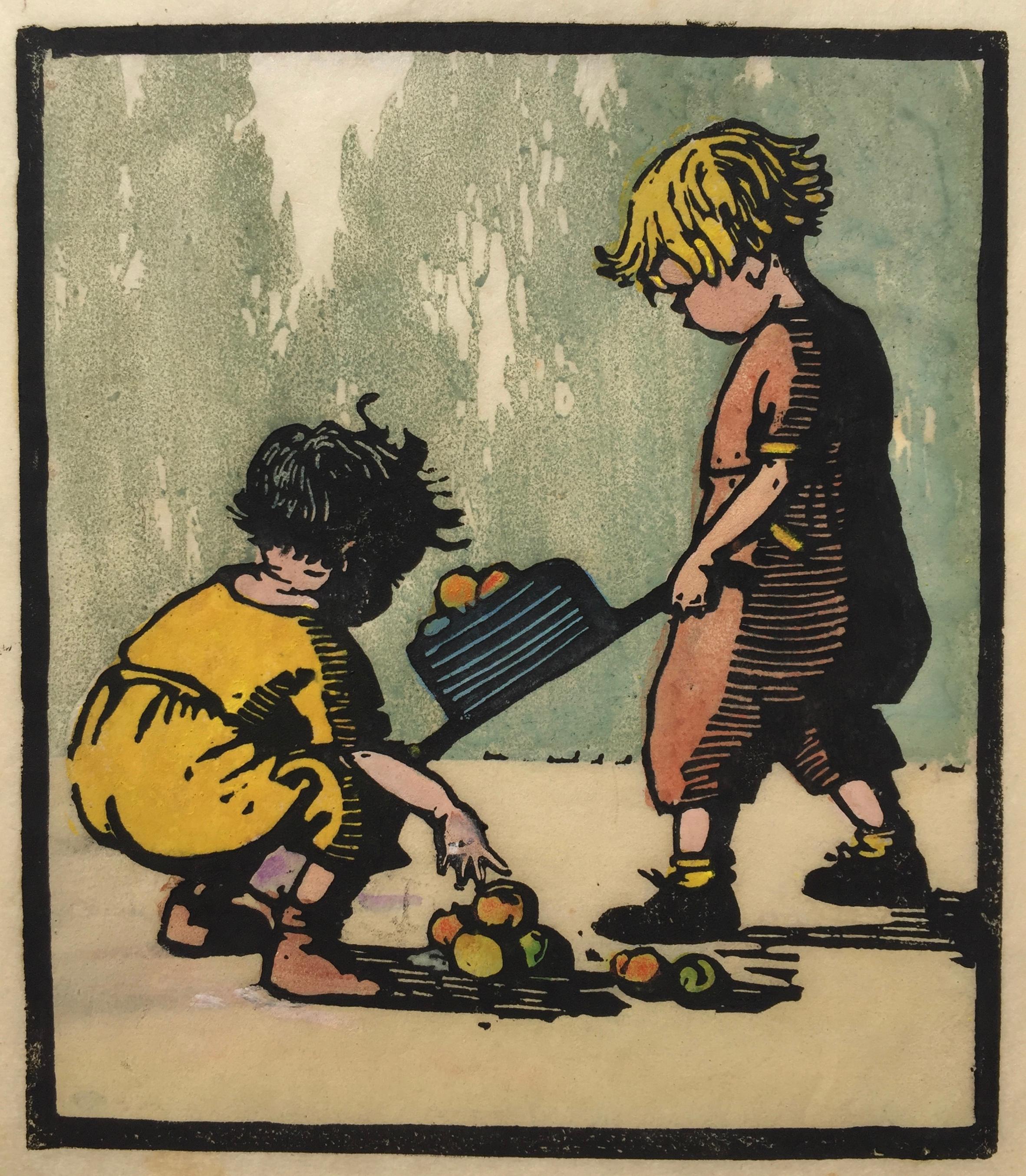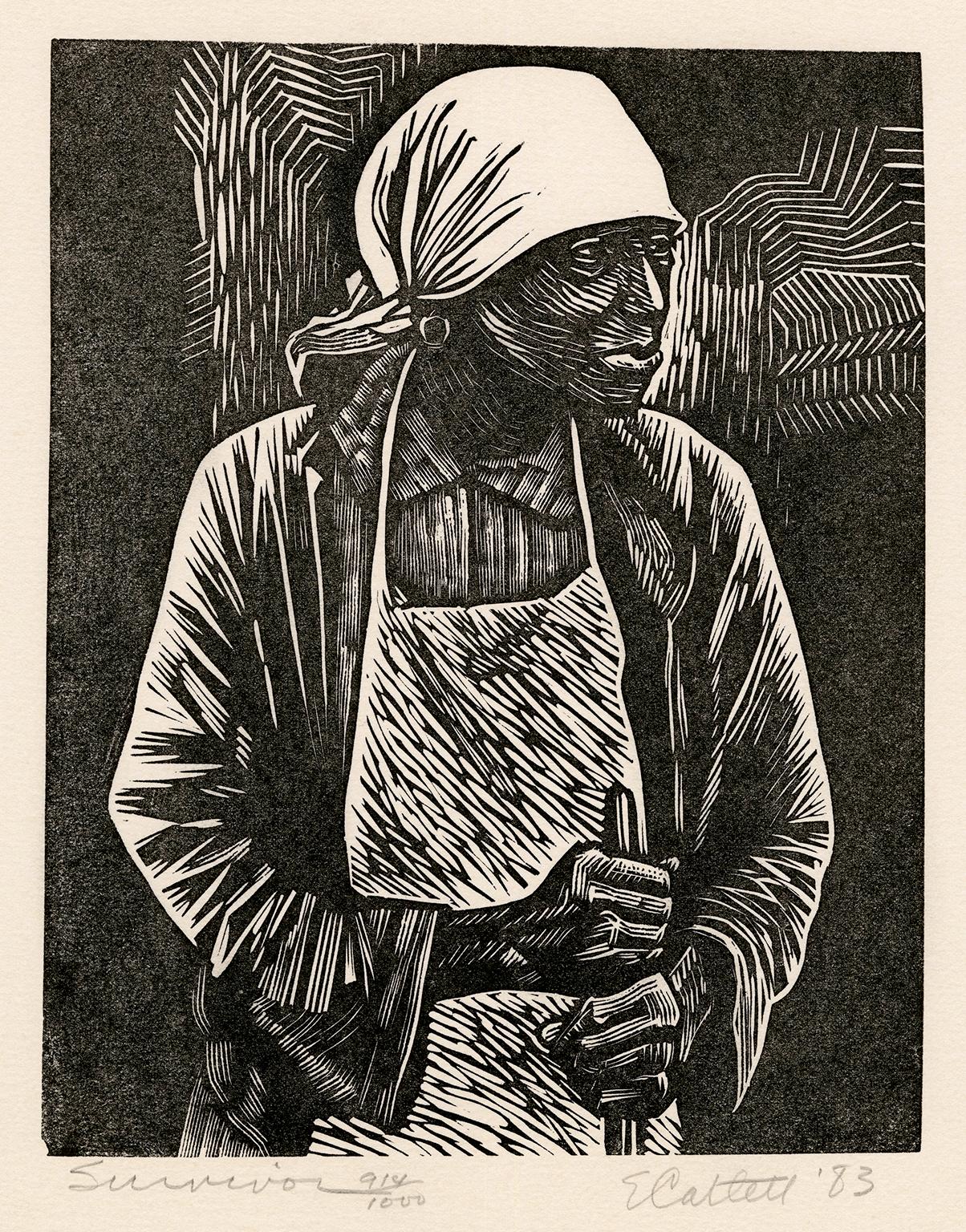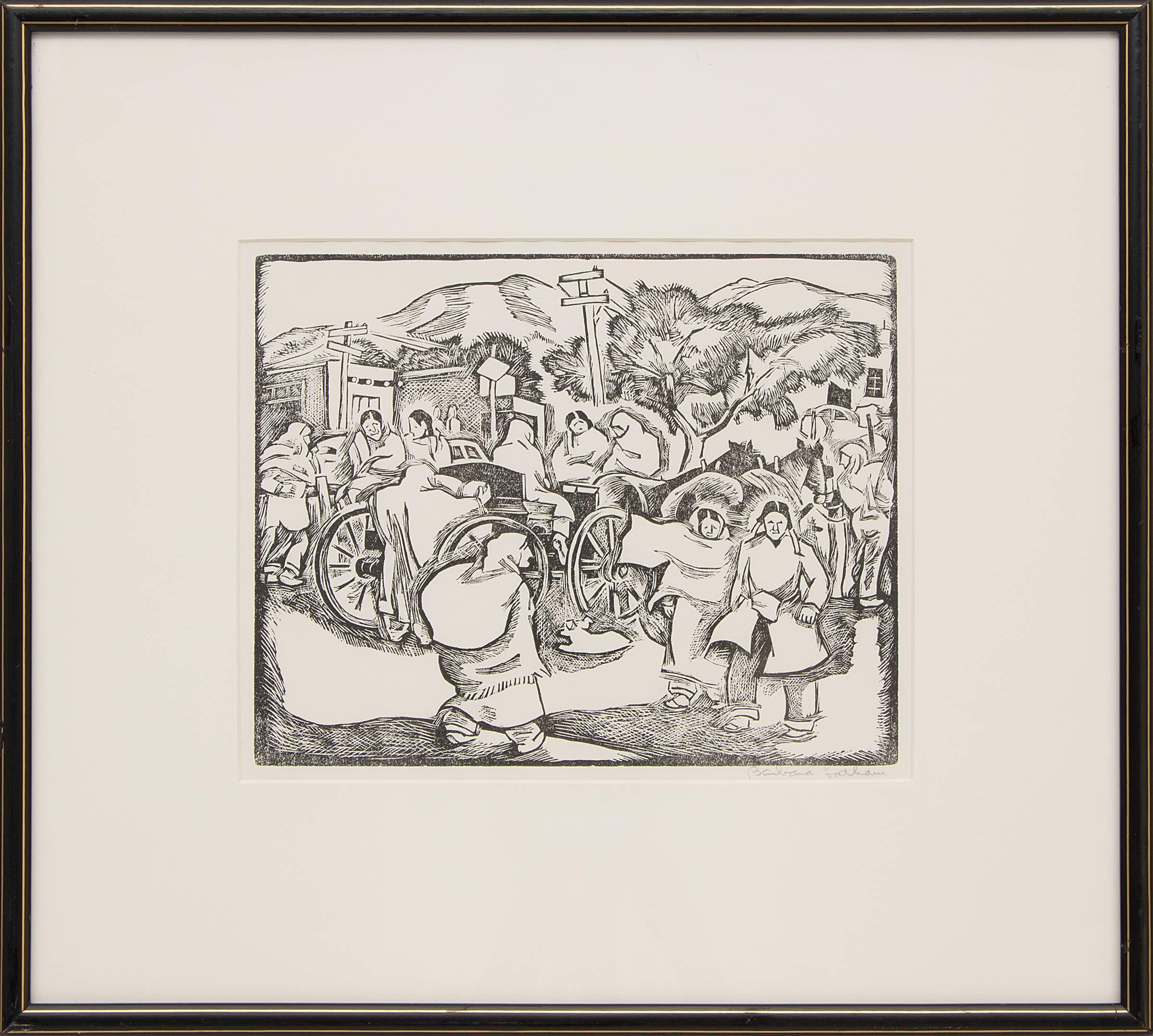Items Similar to 'Commuters' — Early 20th-Century Modernism
Want more images or videos?
Request additional images or videos from the seller
George Josimovich'Commuters' — Early 20th-Century Modernism1922-23
1922-23
About the Item
George Josimovich, 'Commuters', linocut, 1922-23, edition 20. Signed, dated '22, titled, and annotated '9/20' in pencil. Initialed in the block 'G.J. ‘23', lower right. A fine, richly-inked impression, on cream wove paper; the full sheet with margins (2 1/2 to 7 1/4 inches), in good condition. Image size 8 7/8 x 6 7/8 inches; sheet size 19 1/4 x 12 inches. Matted to museum standards, unframed.
“Life is in a constant state of flux-never-ceasing motion. Everything breathes, moves, vibrates. And it is my ardent belief that the same should be true in a work of art. It should be alive, dynamically alive. Every part of it should live and every part of it should contribute life to the creation as a whole. ...anyone who is sensitive and creative enough to deserve to be called an artist will consciously or unconsciously react to...those phases of life with which his particular nature and personality have a special kinship. And all this cannot help but leave an impress upon his work which is and must be, if it is sincere, an objective manifestation of his inner self.” —George Josimovich, Illinois Historical Art Project
ABOUT THE ARTIST
Born in Mitrovica, Yugoslavia (present-day Serbia), George Josimovich (1894 - 1986) immigrated to the United States with his parents and three younger brothers in 1908. The family settled in Fort Laramie and Cheyenne, Wyoming, along the Union Pacific Railroad, where his father worked as a tailor. In 1914, motivated by a newspaper advertisement for the Lockwood Art School in Kalamazoo, Michigan, Josimovich set out for the Midwest to pursue a career in art.
From 1914–19 he studied at the School of the Art Institute of Chicago (SAIC) under Karl Buehr and Randall Davey, and alongside fellow students William Schwartz, Emil Armin, and Archibald J. Motley Jr. During his final year at SAIC, Josimovich enrolled in a life class with visiting professor George Bellows, whose teachings about avant-garde art, geometric composition, color theory, and individualism in art exerted a profound influence. An exhibition of applied arts by German artist Hermann Sachs at the Art Institute of Chicago during the winter of 1920–21 also made a strong impression on the young artist. Josimovich studied under Sachs at Chicago’s Hull House and, along with other former SAIC students, followed Sachs to the Dayton Art Museum in Ohio to establish an expressionist craft program.
Josimovich returned to Chicago in 1922, where he joined the Jackson Park art colony and spent the next four years honing his craft and developing theories on composition and form. His works from this period evince a lively experimentation with modernist principles and techniques in oil and watercolor paintings, prints, and drawings. Familiar genres of figure study, still life, and landscape are distilled into abstract arrangements of fragmented forms in radically flattened pictorial space, often within tightly ordered geometric compositions. Throughout the 1920s Josimovich established himself as a leading contemporary artist in the city, exhibiting with the Chicago No-Jury Society of Artists, The Ten, and the Chicago Society of Artists, where he later served as president. Critics lauded him as quintessentially modern, praising his “rigid intellectualism” and his focus on color, form, and movement. Josimovich’s year in Paris in 1926–27, where he encountered other practitioners of abstraction and the theory of purism, further stimulated his modernist approach to art. His French sojourn culminated in a 1927 solo exhibition at the Galerie d’art contemporain in Paris, which garnered much coverage in the press.
In the 1930s, Josimovich dramatically transformed his art and became an expressionist in the vein of French painter Chaim Soutine. Soutine, who had emigrated to Paris in 1913 from Belarus, rose to international prominence through a major show at the gallery of Paul Guillaume in 1923 and subsequent purchases of his work by American collector Albert Barnes. Josimovich’s portraits, still lifes, and landscapes from this period bear some of the hallmarks of Soutine’s work in their exaggerated figures, quivering masses of color, and dynamic brushstrokes, and as a result, sparked strongly divided commentary among Chicago critics.
In the early 1930s, Josimovich was one of the organizers of the Fifty-seventh Street Art Colony, a group of artists with modernist sympathies, and worked briefly for the artists’ relief program of the Works Progress Administration. He continued to show his work through the 1950s in numerous group exhibitions at the Art Institute of Chicago, with the No-Jury Society of Artists and the Chicago Society of Artists, and in a solo exhibition at Knoedler’s Chicago gallery in 1932.
—edited from an essay by Patricia Smith Scanlan for ‘Modernism in the New City, Chicago Artists, 1920-1950’
- Creator:George Josimovich (1894 - 1986)
- Creation Year:1922-23
- Dimensions:Height: 8.88 in (22.56 cm)Width: 6.88 in (17.48 cm)
- Medium:
- Movement & Style:
- Period:
- Condition:
- Gallery Location:Myrtle Beach, SC
- Reference Number:
About the Seller
5.0
Recognized Seller
These prestigious sellers are industry leaders and represent the highest echelon for item quality and design.
Platinum Seller
These expertly vetted sellers are 1stDibs' most experienced sellers and are rated highest by our customers.
Established in 1995
1stDibs seller since 2016
256 sales on 1stDibs
Typical response time: 1 hour
Associations
International Fine Print Dealers Association
- ShippingRetrieving quote...Ships From: Myrtle Beach, SC
- Return PolicyA return for this item may be initiated within 7 days of delivery.
More From This SellerView All
- 'Survivor' — Elizabeth CatlettBy Elizabeth CatlettLocated in Myrtle Beach, SCElizabeth Catlett, 'Survivor', linocut, 1983, edition 1000. Signed, titled, dated, and numbered '914/1000' in pencil. A fine impression, on...Category
1980s American Modern Figurative Prints
MaterialsLinocut
- Harbor with Sailboats — Early 20th-Century ModernismBy George JosimovichLocated in Myrtle Beach, SCGeorge Josimovich, Untitled (Harbor with Sailboats) ', linocut, 1923, edition 35. Signed, dated, and annotated '4/35' in pencil. Initialed 'G J' in ...Category
1920s American Modern Figurative Prints
MaterialsLinocut
- 'Brooklyn Bridge' — 1920s view of an iconic New York City landmarkBy Luigi KasimirLocated in Myrtle Beach, SCLuigi Kasimir, 'Brooklyn Bridge', color etching with aquatint, 1927, edition 100. Signed in pencil. A superb impression, with fresh colors, on heavy, cream wove paper; with margins...Category
1920s American Modern Landscape Prints
MaterialsEtching, Aquatint
- From the Sea (From the Sea—Pieta)By Benton Murdoch SpruanceLocated in Myrtle Beach, SCA superb, richly inked impression, on off-white wove paper; the full sheet, with deckel all around (margins 1 to 2 inches) in excellent condition. Signed, dated, titled and annotated...Category
1940s American Modern Figurative Prints
MaterialsLithograph
- NeroBy Benton Murdoch SpruanceLocated in Myrtle Beach, SC2-color lithograph, edition 35, 1944, Fine and Looney 233. Signed, dated, titled and annotated 'Ed 35' in pencil. Initialed 'BS' in the image, lower right. A superb, richly inked im...Category
Mid-20th Century American Modern Figurative Prints
MaterialsLithograph
- 'Financial District', New York City — 1930s American ModernismBy Howard Norton CookLocated in Myrtle Beach, SCHoward Cook, 'Financial District', lithograph, 1931, edition 75, Duffy 155. A fine, richly-inked impression, on cream wove paper, the full sheet with wide margins (2 3/4 to 5 5/8 inches), in excellent condition. Image size 13 5/16 x 10 3/8 inches (338 x 264 mm); sheet size 23 x 16 inches (584 x 406 mm). Matted to museum standards, unframed. Literature: 'American Master Prints from the Betty and Douglas Duffy Collection', the Trust for Museum Exhibitions, Washington, D.C., 1987. Collections: Crystal Bridges Museum of American Art, Library of Congress, Metropolitan Museum of Art, Philadelphia Museum of Art, Smithsonian American Art Museum. ABOUT THE ARTIST Howard Norton Cook (1901-1980) was one of the best-known of the second generation of artists who moved to Taos. A native of Massachusetts, he studied at the Art Students League in New York City and at the Woodstock Art Colony. Beginning his association with Taos in 1926, he became a resident of the community in the 1930s. During his career, he received two Guggenheim Fellowships and was elected an Academician in the National Academy of Design. He earned a national reputation as a painter, muralist, and printmaker. Cook’s work in the print mediums received acclaim early in his career with one-person exhibitions at the Denver Art Museum (1927) and the Museum of New Mexico (1928). He received numerous honors and awards over the years, including selection in best-of-the-year exhibitions sponsored by the American Institute of Graphics Arts, the Brooklyn Museum, the Society of American Etchers, and the Philadelphia Print Club. His first Guggenheim Fellowship took him to Taxco, Mexico in 1932 and 1933; his second in the following year enabled him to travel through the American South and Southwest. Cook painted murals for the Public Works of Art Project in 1933 and the Treasury Departments Art Program in 1935. The latter project, completed in Pittsburgh, received a Gold Medal from the Architectural League of New York. One of his most acclaimed commissions was a mural in the San Antonio Post Office in 1937. He and Barbara Latham settled in Talpa, south of Taos, in 1938 and remained there for over three decades. Cook volunteered in World War II as an Artist War Correspondent for the US Navy, where he was deployed in the Pacific. In 1943 he was appointed Leader of a War Art Unit...Category
1930s American Modern Figurative Prints
MaterialsLithograph
You May Also Like
- FRUIT FOR SALEBy Frances H. GearhartLocated in Santa Monica, CAFRANCES H. GEARHART and Sisters (THE GEARHARTS) FRUIT FOR SALE c.1928 Color block print. Unsigned. This is an original block print from “Let’s Play”, an intended but unpublished children’s book done in collaboration with her sisters Edna and May in 1928. Image 8 x 7 inches. On a tissue thin laid paper. Irregular sheet 9 3/8 x 8 1/2. The entire series consisted of over 20 children's images. There were very few printed. The editions of the various children varied but likely no more than 50. This impression very well printed with good colors, Very good condition. The margins are likely as issued with the irregular edges. The margins and paper used for this series varies from one print to the next. A bit of tape remnants at top center sheet edge. A very nice example of this print. It is not unusual for impressions of this series to be unsigned, although many are signed "The Gearharts" The Provenance of this example is fascinating. It was acquired from a gentleman who knew the Gearharts as a child in the early 50's in Pasadena. It was part of a collection given to him by Frances. In his adult years he was in the military and took the collection with him as he traveled around Europe, After 81 years, based on the original prints, this book was published by the “California Book...Category
1920s American Modern Figurative Prints
MaterialsWoodcut, Linocut
- Reclining NudeBy Irene ZevonLocated in Buffalo, NYAn original linocut print by American artist Irene Zevon. The reclining nude is one of Zevon's most coveted subject matters. This 1959 print is one of a series of ten prints.Category
1950s American Modern Figurative Prints
MaterialsPaper, Linocut
- Martha Reed, (Color Abstraction) (Head?)By Martha ReedLocated in New York, NYMartha Reed was the daughter of the artist Doel Reed and as an adult she joined her parents in Taos, New Mexico. There she designed clothes with a south-we...Category
Mid-20th Century American Modern Abstract Prints
MaterialsLinocut
- Saturday Morning (Market, Taos Plaza, New Mexico), 1950s Figural Linocut PrintBy Barbara LathamLocated in Denver, CO1950s modernist linoleum cut print titled 'Saturday Morning (Market, Taos Plaza, New Mexico) by New Mexican artist Barbara Latham. Depicting a busy Saturday morning at the market in Taos Pueblo with horse and cart, Native American figures, adobe buildings and mountains in the background. Presented in a custom frame with all archival materials, outer dimensions measure 16 x 17 ¾ inches. Image size is 8 ½ x 10 ½ inches. About the Artist: Beginning her career as a commercial artist, Barbara Latham travelled to Taos in 1925 seeking material for a greeting card. Serendipitously, she also found her life partner, Howard Cook, who was similarly looking for ideas for illustrations. Perhaps both were fueled in their quest by the tales of their mutual teacher, Andrew Dasburg, who knew of the energy and stimulation of this artist community. Observing local people and customs, Latham created genre scenes that offer a window into this now-vanished time and place. Her lively illustrations for numerous children's books are a significant contribution to that graphic art in the mid-20th century. Born in Walpole, Massachusetts, Latham's student days included Norwich Art School and Pratt Institute in Brooklyn; but it was contact with the charismatic Dasburg at the Art Students League in Woodstock that opened her world and her view of art. Getting work with companies like Norcross Publishing and Forum magazine, she eventually made her way to Taos. Among all the spirited young artists gathered there, she met Howard Cook, who was designing illustrations for Willa Cather's Death Comes to the Archbishop. The two married in Santa Fe and began a nomadic life together. The young couple made their way to Paris, a likely destination for modernist artists. Upon receiving a Guggenheim to study fresco painting in 1932, Cook, along with Latham, took an alternative direction and headed to Taxco, Mexico. At this time, Mexican muralists, such as Diego Rivera, were capturing the attention of progressive artists. During the Depression, both Cook and Latham aligned themselves with a populist ideal. Latham contributed work, such as "Fording the Stream" and "Bear Family," to the American Artists Group, which was founded to produce original prints at affordable prices. The couple also travelled in the Deep South to the Ozarks and to "Alabama's Black Belt." When Latham settled in Taos, she was committed to an art of and for the people. Rather than a romanticized re-creation, her choice of subjects was based in common everyday activities, favoring those which brought people together. Taos Pueblo was an ancient, indigenous community, and Latham's view extended that tradition into a contemporary, multi-ethnic village. Sharing some of the spirit of WPA photographs...Category
Mid-20th Century American Modern Figurative Prints
MaterialsLinocut
- Evelyn G. Schultz, TyphoonLocated in New York, NYThe only mention I can find of Evelyn G. Schultz is that she was a charter member of the San Diego Watercolor Society. But the medium of the linocut (here on tan paper) was frequentl...Category
1940s American Modern Figurative Prints
MaterialsLinocut
- Martha Reed, (Fishing)By Martha ReedLocated in New York, NYMartha Reed was the daughter of the artist Doel Reed and as an adult she joined her parents in Taos, New Mexico. There she designed clothes with a south-we...Category
Mid-20th Century American Modern Abstract Prints
MaterialsLinocut




